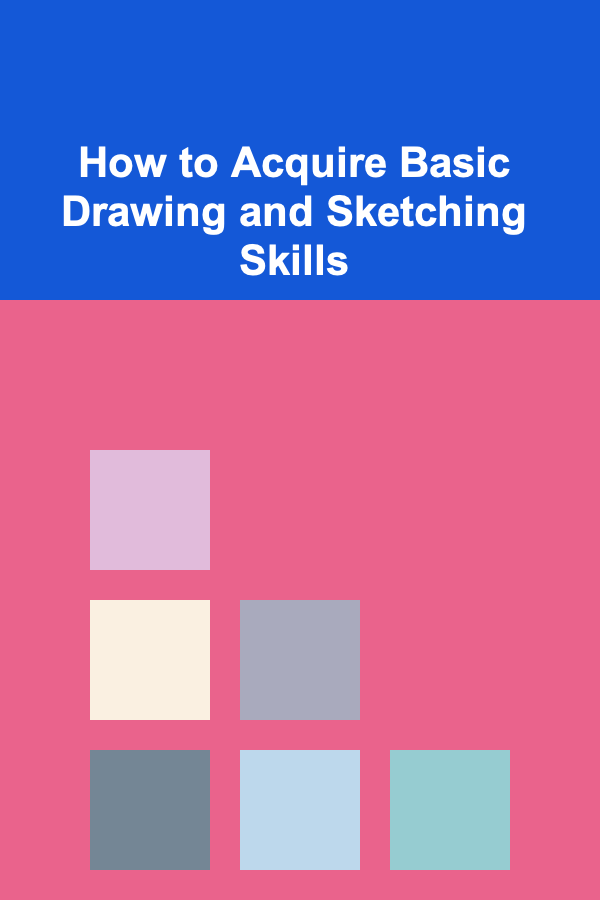
How to Acquire Basic Drawing and Sketching Skills
ebook include PDF & Audio bundle (Micro Guide)
$12.99$9.99
Limited Time Offer! Order within the next:

Drawing and sketching are fundamental skills for artists, designers, and anyone who wants to visually communicate their ideas. They are not innate talents, but rather skills that can be developed through practice, patience, and a structured approach. This guide provides a comprehensive roadmap for acquiring basic drawing and sketching skills, covering fundamental concepts, essential techniques, and effective practice strategies.
The Mindset of a Beginner Artist
Before diving into techniques, it's crucial to establish the right mindset. Many beginners are discouraged by their initial attempts, comparing their work to that of experienced artists. It's important to remember that everyone starts somewhere. Embrace the learning process, be patient with yourself, and focus on progress rather than perfection.
- Embrace Imperfection: Your first drawings will likely not be masterpieces. That's perfectly normal. Focus on learning from each attempt and gradually improving.
- Be Patient: Drawing is a skill that takes time to develop. Don't get discouraged if you don't see results immediately. Consistent practice is key.
- Focus on the Process: Enjoy the act of drawing itself. The satisfaction of creating something, even a simple sketch, is a powerful motivator.
- Don't Compare Yourself to Others: Every artist has their own unique style and journey. Comparing yourself to more experienced artists can be demoralizing. Focus on your own progress.
- Believe in Your Potential: Everyone has the potential to learn how to draw. With dedication and the right approach, you can develop your skills significantly.
Essential Materials for Drawing and Sketching
Having the right tools can make the learning process more enjoyable and effective. While expensive materials are not necessary, investing in a few quality essentials is recommended.
- Pencils: A variety of pencils with different hardness levels (e.g., HB, 2B, 4B, 6B) is ideal. HB pencils are good for general sketching, while softer grades (2B, 4B, 6B) are better for shading and creating darker tones. A mechanical pencil is also useful for fine lines and details.
- Erasers: A kneaded eraser is essential for lifting graphite and creating highlights. A regular eraser is also useful for larger corrections. A retractable eraser is helpful for erasing small details.
- Paper: Sketchbooks with medium-weight paper (around 70-100 lb) are a good starting point. Smooth paper is better for detailed drawings, while textured paper is suitable for sketching and creating interesting effects. Newsprint is a cheaper option for practicing.
- Sharpener: A good quality sharpener is essential for keeping your pencils sharp.
- Blending Tools (Optional): Tortillons (paper stumps), blending stumps, and cotton swabs can be used to blend graphite and create smooth transitions.
- Ruler (Optional): Useful for drawing straight lines and creating accurate proportions.
Fundamental Concepts in Drawing and Sketching
Mastering the fundamental concepts is crucial for building a solid foundation in drawing and sketching. These concepts include:
1. Lines
The line is the most basic element of drawing. Learning to control the quality of your lines is essential. Practice drawing different types of lines: straight lines, curved lines, thick lines, thin lines, dashed lines, and lines with varying pressure. Experiment with different pencil grips to achieve different effects.
- Straight Lines: Practice drawing straight lines of varying lengths and angles. Try drawing them freehand and with a ruler.
- Curved Lines: Practice drawing smooth, flowing curved lines. Try drawing different types of curves: C-curves, S-curves, and spirals.
- Line Weight: Varying the thickness of your lines can create depth and emphasis. Practice drawing lines with different pressure to achieve different weights.
- Gesture Drawing: Focus on capturing the essence of a form with quick, flowing lines. This emphasizes movement and pose rather than precise details.
2. Shapes
All objects can be broken down into basic geometric shapes: circles, squares, triangles, rectangles, and cylinders. Learning to see these shapes in complex objects is essential for understanding form. Practice drawing these shapes in different sizes and orientations.
- Practice Drawing Basic Shapes: Focus on creating clean, accurate shapes.
- Combine Shapes: Practice combining basic shapes to create more complex forms. For example, a person can be represented as a combination of circles, cylinders, and rectangles.
- Negative Space: Pay attention to the space around the objects you are drawing. Understanding negative space can help you improve the accuracy of your drawings.
3. Value (Light and Shadow)
Value refers to the lightness or darkness of a color or tone. Understanding value is crucial for creating the illusion of depth and form in your drawings. Practice creating a value scale, ranging from pure white to pure black, using different pencils and shading techniques.
- Value Scale: Create a value scale using different pencils and shading techniques. Start with pure white and gradually increase the darkness until you reach pure black. Aim for smooth transitions between values.
- Shading Techniques: Experiment with different shading techniques: hatching, cross-hatching, stippling, and blending.
- Hatching: Drawing parallel lines to create value. Closer lines create darker values.
- Cross-Hatching: Drawing intersecting lines to create value. More layers of lines create darker values.
- Stippling: Creating value by using dots. More dots create darker values.
- Blending: Smearing graphite to create smooth transitions between values.
- Light Source: Pay attention to the direction of the light source and how it affects the shadows on the object. This will help you create realistic shading.
4. Perspective
Perspective is a technique for creating the illusion of depth on a flat surface. Understanding perspective is essential for drawing realistic scenes. There are three main types of perspective: one-point, two-point, and three-point perspective.
- One-Point Perspective: All parallel lines converge at a single vanishing point on the horizon line. This is useful for drawing roads, hallways, and other scenes with strong parallel lines.
- Two-Point Perspective: Parallel lines converge at two vanishing points on the horizon line. This is useful for drawing buildings and other objects viewed from an angle.
- Three-Point Perspective: Parallel lines converge at three vanishing points (two on the horizon line and one above or below). This is useful for drawing scenes viewed from a very high or low angle.
- Horizon Line: The horizon line represents the eye level of the viewer. All vanishing points are located on the horizon line.
5. Composition
Composition refers to the arrangement of elements within a drawing or painting. A good composition can make a drawing more visually appealing and engaging. Consider elements such as the rule of thirds, leading lines, and balance when composing your drawings.
- Rule of Thirds: Divide the drawing surface into thirds both horizontally and vertically. Place important elements at the intersections of these lines to create a more dynamic composition.
- Leading Lines: Use lines to guide the viewer's eye through the drawing. Leading lines can create a sense of depth and movement.
- Balance: Create a sense of balance in the drawing by distributing elements evenly. This can be achieved through symmetry or asymmetry.
- Focal Point: Create a focal point that draws the viewer's attention. This can be achieved through contrast, color, or placement.
Essential Drawing and Sketching Techniques
Once you have a basic understanding of the fundamental concepts, you can begin to explore different drawing and sketching techniques.
1. Gesture Drawing
Gesture drawing is a quick and expressive way to capture the essence of a subject. Focus on capturing the movement, pose, and overall form of the subject, rather than precise details. Use loose, flowing lines and don't be afraid to make mistakes. Gesture drawing is excellent practice for improving your observation skills and capturing the energy of a scene.
- Focus on the Overall Form: Don't get bogged down in details. Focus on capturing the overall shape and movement of the subject.
- Use Loose, Flowing Lines: Use loose, flowing lines to capture the energy of the subject.
- Time Yourself: Try drawing gestures in short intervals, such as 30 seconds, 1 minute, or 2 minutes. This will force you to focus on the essentials.
- Practice Regularly: Gesture drawing is a skill that improves with practice. Try to do a few gesture drawings every day.
2. Contour Drawing
Contour drawing involves drawing the outline of a subject without lifting your pencil from the paper. This forces you to carefully observe the subject and translate what you see onto the page. Blind contour drawing, where you don't look at the paper while drawing, is a great exercise for improving your hand-eye coordination.
- Draw Slowly and Deliberately: Take your time and carefully observe the edges of the subject.
- Don't Lift Your Pencil: Try to draw the entire outline of the subject without lifting your pencil from the paper.
- Focus on Accuracy: Pay attention to the subtle curves and angles of the subject.
- Blind Contour Drawing: Try drawing a contour drawing without looking at the paper. This will force you to rely on your observation skills.
3. Cross-Contour Drawing
Cross-contour drawing involves drawing lines that follow the form of the subject, similar to the lines on a topographic map. This technique helps you to understand the three-dimensional form of the subject and create a sense of volume.
- Draw Lines that Follow the Form: Imagine wrapping lines around the subject, following its curves and contours.
- Vary the Spacing of the Lines: Use closer lines to indicate areas that are receding and wider lines to indicate areas that are protruding.
- Use Line Weight to Create Depth: Use thicker lines to emphasize areas that are closer to the viewer and thinner lines to emphasize areas that are further away.
4. Shading Techniques (Hatching, Cross-Hatching, Stippling, Blending)
We discussed these techniques earlier in the context of value. Experiment with each technique to discover which ones you prefer and which ones work best for different subjects. Practice creating smooth transitions between values and achieving a full range of tones.
5. Sketching from Life
Sketching from life is the best way to improve your drawing skills. Observe the world around you and try to capture what you see on paper. Start with simple objects and gradually work your way up to more complex subjects. Sketching from life helps you to develop your observation skills, understand form, and improve your hand-eye coordination.
- Choose Simple Subjects: Start with simple objects, such as a fruit, a cup, or a book.
- Observe Carefully: Take the time to carefully observe the subject before you start drawing. Pay attention to the shapes, values, and proportions.
- Don't Be Afraid to Make Mistakes: Everyone makes mistakes. Learn from your mistakes and keep practicing.
- Carry a Sketchbook with You: Carry a sketchbook with you so you can sketch whenever you have a few spare minutes.
Developing Your Own Style
As you continue to practice, you will begin to develop your own unique style. This is a natural process that occurs as you experiment with different techniques and find what works best for you. Don't try to force a particular style. Just focus on developing your skills and expressing yourself authentically.
- Experiment with Different Techniques: Try different drawing and sketching techniques to see what you like best.
- Study the Work of Other Artists: Look at the work of artists you admire and try to understand their techniques and approaches.
- Find Your Voice: Express yourself authentically in your drawings. Don't try to copy other artists.
- Practice Consistently: The more you practice, the more your style will develop.
Practice Strategies for Improvement
Consistent and focused practice is the key to improving your drawing and sketching skills. Here are some effective practice strategies:
- Set Realistic Goals: Don't try to do too much too soon. Set small, achievable goals and gradually increase the difficulty as you improve.
- Practice Regularly: Try to practice drawing and sketching every day, even if it's just for a few minutes.
- Focus on Specific Skills: Identify areas where you need to improve and focus your practice on those areas.
- Use Reference Images: Use reference images to help you understand form, value, and perspective.
- Get Feedback: Share your work with other artists and ask for feedback.
- Be Patient and Persistent: Learning to draw and sketch takes time and effort. Don't get discouraged if you don't see results immediately. Keep practicing and you will eventually improve.
- Track Your Progress: Keep a sketchbook or online journal of your drawings. Reviewing your past work can help you see how much you've improved and identify areas for further development.
- Find a Community: Join an online or in-person art community. Sharing your work, receiving feedback, and connecting with other artists can be incredibly motivating and helpful.
Resources for Learning and Inspiration
There are many resources available to help you learn and improve your drawing and sketching skills.
- Online Tutorials: Websites like YouTube, Skillshare, and Udemy offer a wide variety of drawing and sketching tutorials.
- Books: There are many excellent books on drawing and sketching available. Some popular titles include "Drawing on the Right Side of the Brain" by Betty Edwards, "Keys to Drawing" by Bert Dodson, and "Figure Drawing: For All It's Worth" by Andrew Loomis.
- Art Classes: Taking an art class can provide you with structured instruction and personalized feedback.
- Museums and Galleries: Visit museums and galleries to study the work of master artists.
- Online Communities: Join online art communities to share your work, get feedback, and connect with other artists.
Conclusion
Acquiring basic drawing and sketching skills is a journey that requires dedication, patience, and a structured approach. By understanding the fundamental concepts, mastering essential techniques, and practicing consistently, anyone can develop their ability to draw and sketch. Remember to embrace the learning process, be patient with yourself, and enjoy the creative journey.

How to Archive Family Heirlooms for Future Generations
Read More
How to Design a Compact Yet Stylish Studio Apartment
Read More
How to Install a Home Security System on Your Own
Read More
How to Make Money Online as a Tester of Websites and Apps
Read More
What Items Are Essential for an Organized Craft Space?
Read More
The Importance of Clutter Clearing for Good Feng Shui
Read MoreOther Products

How to Archive Family Heirlooms for Future Generations
Read More
How to Design a Compact Yet Stylish Studio Apartment
Read More
How to Install a Home Security System on Your Own
Read More
How to Make Money Online as a Tester of Websites and Apps
Read More
What Items Are Essential for an Organized Craft Space?
Read More